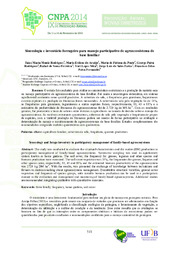Sinecologia e inventário forrageiro para manejo participativo de agroecossistema de base familiar.
Sinecologia e inventário forrageiro para manejo participativo de agroecossistema de base familiar.
Author(s): RODRIGUES, T. M. M.; ARAÚJO, M. E. de; PONTE, M. de F. da; RODRIGUES, G. P.; FERREIRA, R. de S.; SILVA, Y. L.; FARIAS, J. L. de S.; FERNANDES, F. E. P.
Summary: Resumo: O estudo foi conduzido para avaliar as características estruturais e a produção de matéria seca no manejo participativo de agroecossistema de base familiar. Foi usada a amostragem sistemática, em sistema agroflorestal conhecido como quintal produtivo. A cobertura do solo, a frequência para gramíneas, leguminosas e outras espécies e a produção de fitomassa foram mensuradas. A cobertura do solo pela vegetação foi de 18%, as frequências para gramíneas, leguminosas e outras espécies foram, respectivamente, 81, 43 e 88% e a estimativa de produtividade de fitomassa do agroecossistema foi de 2.720 kg de MS ha-1. Com os resultados gerados, foi promovida a troca de saberes entre técnicos e agricultores na tomada de decisão sobre o manejo do agroecossistema. As variáveis estruturais quantitativas, cobertura do solo pela vegetação e frequência de grupos de espécies, com a variável produção de fitomassa podem ser usadas de forma participativa na avaliação e determinação de manejo e monitoramento de agroecossistemas de base familiar. Estudos complementares são recomendados integrando medidas quantitativas com qualitativas. [Synecology and forage inventory in participatory management of family-based agroecosystems]. Abstract: The study was conducted to evaluate the structural characteristics and dry matter (DM) production in participatory management of family-based agroecosystems. Systematic sampling was used in agroforestry system known as home gardens. The soil cover, the frequency for grasses, legumes and other species and biomass production were measured. The soil cover vegetation was 18%, the frequencies for grasses, legumes and other species were, respectively, 81, 43 and 88% and the estimated biomass productivity of the agroecosystem was 2720 kg DM ha-1. With the results, was promoted the exchange of knowledge between technicians and farmers in decision-making about agroecosystem management. Quantitative structural variables, ground cover vegetation and frequency of species groups, with variable biomass production can be used in a participatory manner in the evaluation and management and monitoring of family-based agroecosystems. Additional studies are recommended integrating qualitative with quantitative measures.
Publication year: 2014
Types of publication: Paper in annals and proceedings
Unit: Embrapa Goats & Sheep
Keywords: Agricultura familiar, Quintais produtivos
Observation
Some of Embrapa's publications are published as ePub files. To read them, use or download one of the following free software options to your computer or mobile device. Android: Google Play Books; IOS: iBooks; Windows and Linux: Calibre.
Access other publications
Access the Agricultural Research Database (BDPA) to consult Embrapa's full library collection and records.
Visit Embrapa Bookstore to purchase books and other publications sold by Embrapa.

